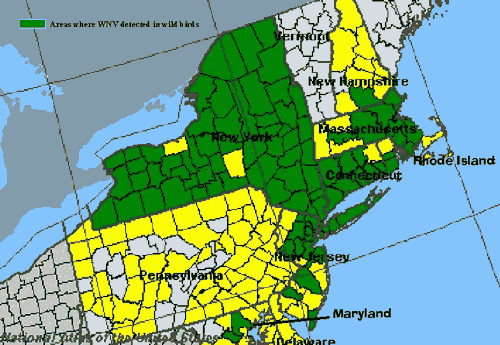
 |
|
||||||||||||||||||||||||||||||||||||||||||||||||||||||||||||||||||||||||||
|
To: Natural
Resource/Conservation Managers This is an update of the March 2000, USGS Wildlife Health Alert (WHA 00-01) on West Nile Virus. West Nile virus (WNV) is an arthropod-borne virus that had never been reported in the Western Hemisphere until the fall of 1999. Wild birds, primarily crows, were affected in last year's outbreak in the greater New York City area along with several other native North American bird species, horses, and people. This year, wild bird mortality due to WNV was first detected in May 2000 in southeastern New York and northeastern New Jersey. Since then the disease has continued to expand both geographically (see map) and in the number and variety of species infected (see table). West Nile virus has been isolated from over 63 species of birds, including 53 free-ranging species from 7 states. Free-living mammal species in New York were found positive for WNV for the first time this year (see table). The virus has again been detected in 8 horses from 5 states. Twelve people are reported as clinically ill from WNV this year however, no human deaths from WNV are reported. Wildlife health biologists at USGS' National Wildlife Health Center are concerned that the fall migration of millions of birds from and through the 400 mile wide infected region in the northeastern United States may move West Nile virus southward along the Atlantic and Gulf coast states. On September 21, 2000, Maryland officials reported their first two WNV positive birds this year. The species that appears to be the most susceptible and has been found in the greatest numbers is the American crow. There is also high mortality in blue jays, another member of the Corvidae family. Wildlife involvement in the WNV outbreak continues to expand with the recent finding of free-living mammals positive for WNV including three species of bats, a raccoon, and an eastern chipmunk in New York. Surveillance efforts have also detected a number of mosquito species positive for WNV (see table for species) including species active at dawn and dusk, and species active during the day. The mosquitoes found positive include species that feed on both avian and mammalian hosts. The USGS National Wildlife Health Center (USGS-NWHC) is continuing to provide diagnostic support to federal, state, and local wildlife agencies, as well as public health departments and other federal agencies that are utilizing dead wild birds as sentinels for detecting WNV activity in their area. Active surveillance to detect the geographic expansion of the virus is ongoing in collaboration with USDA, FWS, NPS, and state wildlife agencies that are sampling free-ranging wild bird populations in the eastern U.S. from New Hampshire to Louisiana. This year USGS-NWHC is working with the Centers for Disease Control in field investigations in New York and New Jersey to determine the level of West Nile virus activity in wild birds and mosquitoes in areas where positive dead birds were found. USGS-NWHC is also conducting research studies to determine the virulence of West Nile virus in crows and waterfowl. USGS has initiated a National Atlas web site to provide interactive, multimedia, and printer-friendly editions of the status of the National West Nile Virus surveillance program (see included map). These maps can be accessed at http://nationalatlas.gov/virusmap.html. USGS continues to provide GIS and remote sensing support to field teams. For further information and to report sick or dead crows or unusual bird mortality, please contact USGS, Wildlife Disease Specialist Dr. Linda Glaser, NWHC WNV Coordinator at 608-270-2446. Free-Ranging Native North American species positive for WNV
DISTRIBUTION OF WEST NILE VIRUS IN 2000 
|
||||||||||||||||||||||||||||||||||||||||||||||||||||||||||||||||||||||||||
|
||||||||||||||||||||||||||||||||||||||||||||||||||||||||||||||||||||||||||